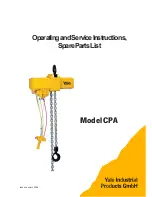
115/118
This document and the information contained herein, is the exclusive property of R&M Materials Handling Inc. and represents a non-public, confidential and proprietary trade
secret that may not be reproduced, disclosed to third parties, altered or otherwise employed in any manner whatsoever without the express written consent of R&M Materials
Handling Inc. Copyright 2020 © R&M Materials Handling Inc. All rights reserved.
APPENDIX: REPLACING THE CONTROL VOLTAGE FUSE
Power supply board with control voltage fuse (1)
1
Disconnect the hoist from the main power supply network.
2
The control voltage fuse can be found on the power supply board which is located on the brake side of the hoist.
Remove the fuse gently from its holder. Make sure not to damage the other components.
3
Check the condition of the fuse.
Glass fuse:
• Check the fuse for burn marks. If burn marks can be found, this is an indicator that fuse is blown. Replace the fuse.
• Check the filament. If the filament is inconstant, this is an indicator that the fuse is blown. Replace the fuse.
• If the filament is constant and there no burn marks on the fuse, the fuse is in good condition.
Ceramic fuse:
If a ceramic fuse is used, use a continuity checker or a multimeter/ohmmeter to check
the condition of the fuse.
• Continuity checker: Connect the leads to both ends of the fuse. If you cannot hear a beep, the fuse is blown.
• Multi-/ohmmeter: Connect the leads to both ends of the fuse. Set the meter at 1Ω.
If the meter shows a value that is close to 1
Ω, the fuse is normally in good condition.
If no value is shown, it is an indicator that the fuse is blown. Replace the fuse.
4
If the fuse is blown, replace it with a new one. Check the correct rating for the new fuse from the blown fuse.
5
Place the new fuse gently to the holder.
6
Connect the hoist back to the main power supply network.






















